Deck 10: Monopolistic Competition, Product Differentiation, Monopoly and Antitrust
Question
Question
Question
Question
Question
Question
Question
Question
Question
Question
Question
Question
Question
Question
Question
Question
Question
Question
Question
Question
Question
Question
Question
Question
Question
Question
Question
Question
Question
Question
Question
Question
Question
Question
Question
Question
Question
Question
Question
Question
Question
Question
Question
Question
Question
Question
Question
Question
Question
Question

Unlock Deck
Sign up to unlock the cards in this deck!
Unlock Deck
Unlock Deck
1/50
Play
Full screen (f)
Deck 10: Monopolistic Competition, Product Differentiation, Monopoly and Antitrust
1
Exhibit
The following diagram depicts monopolistically competitive firms.?

-Refer to Exhibit. The firm illustrated in Graph A above maximizes profits (minimizes losses) by producing at level of output ____ and charging price ____.
A)q1; P1
B)q2; P1
C)q1; P2
D)q2; P2
The following diagram depicts monopolistically competitive firms.?

-Refer to Exhibit. The firm illustrated in Graph A above maximizes profits (minimizes losses) by producing at level of output ____ and charging price ____.
A)q1; P1
B)q2; P1
C)q1; P2
D)q2; P2
q1; P1
2
Exhibit
The following diagram depicts monopolistically competitive firms.?

-Refer to Exhibit. In Graph B above, the firm will maximize profits (minimize losses) by producing at level of output ____ and charging price ____.
A)q1; P1
B)q2; P1
C)q1; P2
D)q2; P2
The following diagram depicts monopolistically competitive firms.?

-Refer to Exhibit. In Graph B above, the firm will maximize profits (minimize losses) by producing at level of output ____ and charging price ____.
A)q1; P1
B)q2; P1
C)q1; P2
D)q2; P2
q1; P1
3
Exhibit
The following diagram depicts monopolistically competitive firms.?

-Refer to Exhibit. In Graph B, a profit-maximizing (loss-minimizing) firm will experience a ____ at output quantity ____.
A)loss; q1
B)loss; q2
C)profit; q1
D)profit; q2
The following diagram depicts monopolistically competitive firms.?

-Refer to Exhibit. In Graph B, a profit-maximizing (loss-minimizing) firm will experience a ____ at output quantity ____.
A)loss; q1
B)loss; q2
C)profit; q1
D)profit; q2
loss; q1
4
Exhibit
The following diagram depicts monopolistically competitive firms.?

-Refer to Exhibit. In Graph B, the profit-maximizing (loss-minimizing) firm is making a ____ shown by the area ____.
A)profit; P1 V R S
B)loss; P2 P1 S T
C)profit; P2 P1 S T
D)loss; P1 V R S
The following diagram depicts monopolistically competitive firms.?

-Refer to Exhibit. In Graph B, the profit-maximizing (loss-minimizing) firm is making a ____ shown by the area ____.
A)profit; P1 V R S
B)loss; P2 P1 S T
C)profit; P2 P1 S T
D)loss; P1 V R S

Unlock Deck
Unlock for access to all 50 flashcards in this deck.
Unlock Deck
k this deck
5
Exhibit
The following diagrams depict firms in monopolistically competitive markets.
?
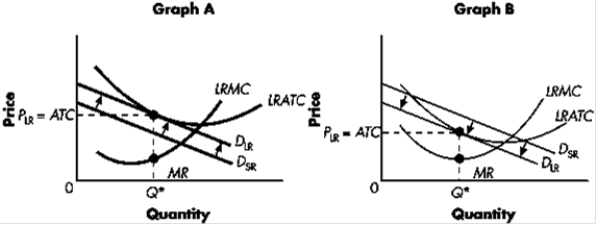
-Refer to Exhibit. Graph ____ demonstrates firms entering the market, and a resulting ____ of the firm's share of the market.
A)A; increase
B)B; increase
C)A; decrease
D)B; decrease
The following diagrams depict firms in monopolistically competitive markets.
?

-Refer to Exhibit. Graph ____ demonstrates firms entering the market, and a resulting ____ of the firm's share of the market.
A)A; increase
B)B; increase
C)A; decrease
D)B; decrease

Unlock Deck
Unlock for access to all 50 flashcards in this deck.
Unlock Deck
k this deck
6
Exhibit
The following diagrams depict firms in monopolistically competitive markets.
?

-Refer to Exhibit. Graph ____ demonstrates firms exiting the market, and a resulting ____ of the firm's share of the market.
A)A; increase
B)B; increase
C)A; decrease
D)B; decrease
The following diagrams depict firms in monopolistically competitive markets.
?

-Refer to Exhibit. Graph ____ demonstrates firms exiting the market, and a resulting ____ of the firm's share of the market.
A)A; increase
B)B; increase
C)A; decrease
D)B; decrease

Unlock Deck
Unlock for access to all 50 flashcards in this deck.
Unlock Deck
k this deck
7
?Exhibit
The graph depicts a monopolistically competitive firm's demand, marginal revenue, and cost curves.

-Refer to Exhibit. If the firm produces the profit-maximizing (or loss-minimizing) level of output, it will produce:
A)100 sweaters each week.
B)85 sweaters each week.
C)70 sweaters each week.
D)60 sweaters each week.
The graph depicts a monopolistically competitive firm's demand, marginal revenue, and cost curves.

-Refer to Exhibit. If the firm produces the profit-maximizing (or loss-minimizing) level of output, it will produce:
A)100 sweaters each week.
B)85 sweaters each week.
C)70 sweaters each week.
D)60 sweaters each week.

Unlock Deck
Unlock for access to all 50 flashcards in this deck.
Unlock Deck
k this deck
8
?Exhibit
The graph depicts a monopolistically competitive firm's demand, marginal revenue, and cost curves.

-Refer to Exhibit. Based on the diagram, it follows that:
A)new firms will enter the industry.
B)existing firms will exit the industry.
C)the firm is operating in long-run equilibrium.
D)the firm could minimize average cost by producing 85 sweaters each week.
The graph depicts a monopolistically competitive firm's demand, marginal revenue, and cost curves.

-Refer to Exhibit. Based on the diagram, it follows that:
A)new firms will enter the industry.
B)existing firms will exit the industry.
C)the firm is operating in long-run equilibrium.
D)the firm could minimize average cost by producing 85 sweaters each week.

Unlock Deck
Unlock for access to all 50 flashcards in this deck.
Unlock Deck
k this deck
9
?Exhibit
The graph depicts a monopolistically competitive firm's demand, marginal revenue, and cost curves.

-Refer to Exhibit. To maximize profit (or minimize losses), the firm will charge:
A)$38 per sweater.
B)$44 per sweater.
C)$50 per sweater.
D)$56 per sweater.
The graph depicts a monopolistically competitive firm's demand, marginal revenue, and cost curves.

-Refer to Exhibit. To maximize profit (or minimize losses), the firm will charge:
A)$38 per sweater.
B)$44 per sweater.
C)$50 per sweater.
D)$56 per sweater.

Unlock Deck
Unlock for access to all 50 flashcards in this deck.
Unlock Deck
k this deck
10
A natural monopolist will voluntarily choose to produce at the point where P = MC.

Unlock Deck
Unlock for access to all 50 flashcards in this deck.
Unlock Deck
k this deck
11
Perfectly competitive firms and monopolists are different because
A)in perfect competition MC = P, while a monopolist produces where P > MC.
B)in perfect competition MC = P, while a monopolist produces where MC > P.
C)in perfect competition P > MC, while a monopolist produces where MC = P.
D)in perfect competition MC > P, while a monopolist produces where MC = P.
A)in perfect competition MC = P, while a monopolist produces where P > MC.
B)in perfect competition MC = P, while a monopolist produces where MC > P.
C)in perfect competition P > MC, while a monopolist produces where MC = P.
D)in perfect competition MC > P, while a monopolist produces where MC = P.

Unlock Deck
Unlock for access to all 50 flashcards in this deck.
Unlock Deck
k this deck
12
Based on the table below what is the marginal revenue of the 14th unit of output??QuantityPrice13$50.0014$49.7515$49.50
A)$0.25
B)$46.00
C)$46.50
D)$49.75
A)$0.25
B)$46.00
C)$46.50
D)$49.75

Unlock Deck
Unlock for access to all 50 flashcards in this deck.
Unlock Deck
k this deck
13
Based on the table below what is the marginal revenue of the 28th unit of output??QuantityPrice27$28.5028$27.0029$25.50?
A)-$16.50
B)-$13.50
C)$13.50
D)$16.50
A)-$16.50
B)-$13.50
C)$13.50
D)$16.50

Unlock Deck
Unlock for access to all 50 flashcards in this deck.
Unlock Deck
k this deck
14
?Exhibit

-Refer to Exhibit. The profit-maximizing firm will produce at what level of output?
A)Q1
B)Q2
C)Q3
D)None of the above.

-Refer to Exhibit. The profit-maximizing firm will produce at what level of output?
A)Q1
B)Q2
C)Q3
D)None of the above.

Unlock Deck
Unlock for access to all 50 flashcards in this deck.
Unlock Deck
k this deck
15
?Exhibit

-Refer to Exhibit. If the firm is profit maximizing, the region bounded by CADE represents:
A)total costs.
B)total losses.
C)total profits.
D)total consumer surplus.

-Refer to Exhibit. If the firm is profit maximizing, the region bounded by CADE represents:
A)total costs.
B)total losses.
C)total profits.
D)total consumer surplus.

Unlock Deck
Unlock for access to all 50 flashcards in this deck.
Unlock Deck
k this deck
16
?Exhibit

-Refer to Exhibit. The socially efficient level of output equals:
A)Q1
B)Q2
C)Q3
D)none of the above.

-Refer to Exhibit. The socially efficient level of output equals:
A)Q1
B)Q2
C)Q3
D)none of the above.

Unlock Deck
Unlock for access to all 50 flashcards in this deck.
Unlock Deck
k this deck
17
?Exhibit

-Refer to Exhibit. The profit-maximizing firm's total revenue is indicated in the diagram as area:
A)0CEQ1.
B)0BFQ2.
C)0ADQ1.
D)CADE.

-Refer to Exhibit. The profit-maximizing firm's total revenue is indicated in the diagram as area:
A)0CEQ1.
B)0BFQ2.
C)0ADQ1.
D)CADE.

Unlock Deck
Unlock for access to all 50 flashcards in this deck.
Unlock Deck
k this deck
18
?Exhibit

-Refer to Exhibit. Total cost when the monopolist is maximizing profits is indicated by area:
A)0CEQ1.
B)0BFQ2.
C)0ADQ1.
D)CADE.

-Refer to Exhibit. Total cost when the monopolist is maximizing profits is indicated by area:
A)0CEQ1.
B)0BFQ2.
C)0ADQ1.
D)CADE.

Unlock Deck
Unlock for access to all 50 flashcards in this deck.
Unlock Deck
k this deck
19
?Exhibit

-Refer to Exhibit. The welfare loss due to monopoly is indicated in the diagram as area:
A)DGE.
B)DFH.
C)DFQ2Q1.
D)EGQ3Q1.

-Refer to Exhibit. The welfare loss due to monopoly is indicated in the diagram as area:
A)DGE.
B)DFH.
C)DFQ2Q1.
D)EGQ3Q1.

Unlock Deck
Unlock for access to all 50 flashcards in this deck.
Unlock Deck
k this deck
20
?Exhibit
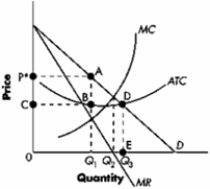
-Refer to Exhibit. The profit-maximizing firm will produce at what level of output?
A)Q1
B)Q2
C)Q3
D)zero units

-Refer to Exhibit. The profit-maximizing firm will produce at what level of output?
A)Q1
B)Q2
C)Q3
D)zero units

Unlock Deck
Unlock for access to all 50 flashcards in this deck.
Unlock Deck
k this deck
21
?Exhibit

-Refer to Exhibit. The region bounded by P*ABC represents:
A)total costs.
B)total losses.
C)total profits.
D)total consumer surplus.

-Refer to Exhibit. The region bounded by P*ABC represents:
A)total costs.
B)total losses.
C)total profits.
D)total consumer surplus.

Unlock Deck
Unlock for access to all 50 flashcards in this deck.
Unlock Deck
k this deck
22
What is the maximum amount of economic profit that the firm below could generate?? 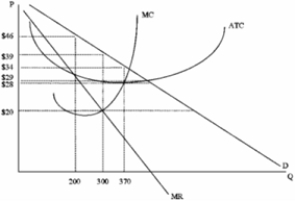
A)$222
B)$300
C)$330
D)$370

A)$222
B)$300
C)$330
D)$370

Unlock Deck
Unlock for access to all 50 flashcards in this deck.
Unlock Deck
k this deck
23
Exhibit
Consider the following demand and cost information for a monopoly.

-Refer to Exhibit. What is the marginal revenue of the 2nd unit?
A)$2
B)$4
C)$10
D)$14
Consider the following demand and cost information for a monopoly.

-Refer to Exhibit. What is the marginal revenue of the 2nd unit?
A)$2
B)$4
C)$10
D)$14

Unlock Deck
Unlock for access to all 50 flashcards in this deck.
Unlock Deck
k this deck
24
Exhibit
Consider the following demand and cost information for a monopoly.

-Refer to Exhibit. What is the marginal cost of the 3rd unit?
A)$2
B)$7
C)$16
D)$31
Consider the following demand and cost information for a monopoly.

-Refer to Exhibit. What is the marginal cost of the 3rd unit?
A)$2
B)$7
C)$16
D)$31

Unlock Deck
Unlock for access to all 50 flashcards in this deck.
Unlock Deck
k this deck
25
Exhibit
Consider the following demand and cost information for a monopoly.

-Refer to Exhibit. What price should the monopoly charge to maximize profit?
A)$8
B)$10
C)$12
D)$14
Consider the following demand and cost information for a monopoly.

-Refer to Exhibit. What price should the monopoly charge to maximize profit?
A)$8
B)$10
C)$12
D)$14

Unlock Deck
Unlock for access to all 50 flashcards in this deck.
Unlock Deck
k this deck
26
Exhibit
Consider the following demand and cost information for a monopoly.

-Refer to Exhibit. At the profit-maximizing price, how much profit will the monopoly earn?
A)$4
B)$5
C)$6
D)$7
Consider the following demand and cost information for a monopoly.

-Refer to Exhibit. At the profit-maximizing price, how much profit will the monopoly earn?
A)$4
B)$5
C)$6
D)$7

Unlock Deck
Unlock for access to all 50 flashcards in this deck.
Unlock Deck
k this deck
27
Exhibit
Consider the following demand and cost information for a monopoly.

-Refer to Exhibit. What is the monopolist's average total cost of production at the profit-maximizing price?
A)$6
B)$7
C)$8
D)$8.5
Consider the following demand and cost information for a monopoly.

-Refer to Exhibit. What is the monopolist's average total cost of production at the profit-maximizing price?
A)$6
B)$7
C)$8
D)$8.5

Unlock Deck
Unlock for access to all 50 flashcards in this deck.
Unlock Deck
k this deck
28
Exhibit
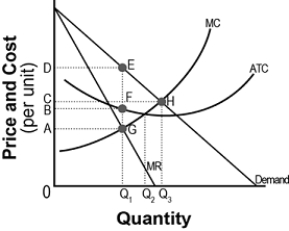
-Refer to Exhibit. What price will the monopolist charge?
A)A
B)D
C)B
D)C

-Refer to Exhibit. What price will the monopolist charge?
A)A
B)D
C)B
D)C

Unlock Deck
Unlock for access to all 50 flashcards in this deck.
Unlock Deck
k this deck
29
Exhibit

-Refer to Exhibit. How much output will the monopolist produce?
A) Q1
B) Q2
C) Q3
D) zero

-Refer to Exhibit. How much output will the monopolist produce?
A) Q1
B) Q2
C) Q3
D) zero

Unlock Deck
Unlock for access to all 50 flashcards in this deck.
Unlock Deck
k this deck
30
Exhibit

-Refer to Exhibit. What area measures the monopolist's profit?
A) BFGA
B) DEFB
C) DEGA
D) BFQ10

-Refer to Exhibit. What area measures the monopolist's profit?
A) BFGA
B) DEFB
C) DEGA
D) BFQ10

Unlock Deck
Unlock for access to all 50 flashcards in this deck.
Unlock Deck
k this deck
31
Exhibit

-Refer to Exhibit. What area measures the monopolist's total costs?
A) AGQ10
B) DEQ10
C) BFQ10
D) CHQ30

-Refer to Exhibit. What area measures the monopolist's total costs?
A) AGQ10
B) DEQ10
C) BFQ10
D) CHQ30

Unlock Deck
Unlock for access to all 50 flashcards in this deck.
Unlock Deck
k this deck
32
Exhibit

-Refer to Exhibit. What area measures the monopolist's total revenue?
A) AGQ10
B) DEQ10
C) BFQ10
D) CHQ30

-Refer to Exhibit. What area measures the monopolist's total revenue?
A) AGQ10
B) DEQ10
C) BFQ10
D) CHQ30

Unlock Deck
Unlock for access to all 50 flashcards in this deck.
Unlock Deck
k this deck
33
?Exhibit
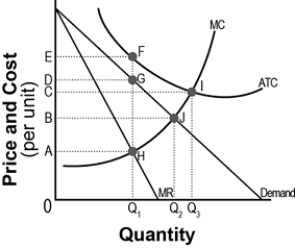
-Refer to Exhibit. What price will the monopolist charge?
A)A
B)D
C)B
D)C

-Refer to Exhibit. What price will the monopolist charge?
A)A
B)D
C)B
D)C

Unlock Deck
Unlock for access to all 50 flashcards in this deck.
Unlock Deck
k this deck
34
?Exhibit

-Refer to Exhibit. How much output will the monopolist produce?
A) Q1
B) Q2
C) Q3
D) zero

-Refer to Exhibit. How much output will the monopolist produce?
A) Q1
B) Q2
C) Q3
D) zero

Unlock Deck
Unlock for access to all 50 flashcards in this deck.
Unlock Deck
k this deck
35
?Exhibit

-Refer to Exhibit. What area measures the monopolist's loss?
A) EFHA
B) CIJB
C) EFGD
D) AHQ10

-Refer to Exhibit. What area measures the monopolist's loss?
A) EFHA
B) CIJB
C) EFGD
D) AHQ10

Unlock Deck
Unlock for access to all 50 flashcards in this deck.
Unlock Deck
k this deck
36
?Exhibit

-Refer to Exhibit. What area measures the monopolist's total costs?
A) AGQ10
B) DGQ10
C) AHQ10
D) BJQ20

-Refer to Exhibit. What area measures the monopolist's total costs?
A) AGQ10
B) DGQ10
C) AHQ10
D) BJQ20

Unlock Deck
Unlock for access to all 50 flashcards in this deck.
Unlock Deck
k this deck
37
?Exhibit

-Refer to Exhibit. What area measures the monopolist's total revenue?
A) EFQ10
B) DGQ10
C) AHQ10
D) CIQ30

-Refer to Exhibit. What area measures the monopolist's total revenue?
A) EFQ10
B) DGQ10
C) AHQ10
D) CIQ30

Unlock Deck
Unlock for access to all 50 flashcards in this deck.
Unlock Deck
k this deck
38
Which of the following is (are) true of a monopoly?
(i)A monopoly has the ability to set its price.
(ii)A monopolists marginal revenue will always increase when it lowers the price of its product.
(iii)A monopoly can never experience an economic loss.
A)(i) only
B)(ii) only
C)(i) and (ii) only
D)(ii) and (iii) only
(i)A monopoly has the ability to set its price.
(ii)A monopolists marginal revenue will always increase when it lowers the price of its product.
(iii)A monopoly can never experience an economic loss.
A)(i) only
B)(ii) only
C)(i) and (ii) only
D)(ii) and (iii) only

Unlock Deck
Unlock for access to all 50 flashcards in this deck.
Unlock Deck
k this deck
39
Exhibit
The following diagram contains information on cost and revenue curves facing a regulated monopoly.
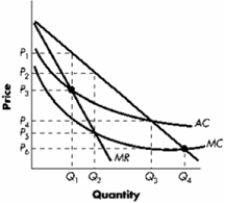
-Refer to Exhibit. If the government is able to regulate the monopolist using marginal-cost pricing, what price and output combinations are expected to result?
A)P5 and Q2
B)P2 and Q2
C)P4 and Q3
D)P6 and Q4
The following diagram contains information on cost and revenue curves facing a regulated monopoly.

-Refer to Exhibit. If the government is able to regulate the monopolist using marginal-cost pricing, what price and output combinations are expected to result?
A)P5 and Q2
B)P2 and Q2
C)P4 and Q3
D)P6 and Q4

Unlock Deck
Unlock for access to all 50 flashcards in this deck.
Unlock Deck
k this deck
40
Exhibit
The following diagram contains information on cost and revenue curves facing a regulated monopoly.

-Refer to Exhibit. If the government is able to regulate the monopolist using average-cost pricing, what price and output combinations are expected to result?
A)P5 and Q2
B)P2 and Q2
C)P4 and Q3
D)P6 and Q4
The following diagram contains information on cost and revenue curves facing a regulated monopoly.

-Refer to Exhibit. If the government is able to regulate the monopolist using average-cost pricing, what price and output combinations are expected to result?
A)P5 and Q2
B)P2 and Q2
C)P4 and Q3
D)P6 and Q4

Unlock Deck
Unlock for access to all 50 flashcards in this deck.
Unlock Deck
k this deck
41
Exhibit
The following diagram contains information on cost and revenue curves facing a regulated monopoly.

-Refer to Exhibit. If regulators set a price according to marginal-cost pricing, the firm will:
A)earn positive economic profits.
B)make zero economic profits.
C)suffer an economic loss.
D)earn the same level of profits as it would absent regulation.
The following diagram contains information on cost and revenue curves facing a regulated monopoly.

-Refer to Exhibit. If regulators set a price according to marginal-cost pricing, the firm will:
A)earn positive economic profits.
B)make zero economic profits.
C)suffer an economic loss.
D)earn the same level of profits as it would absent regulation.

Unlock Deck
Unlock for access to all 50 flashcards in this deck.
Unlock Deck
k this deck
42
Exhibit

-Refer to Exhibit. What quantity of output would a profit-maximizing monopolist produce?
A)Q4
B)Q1
C)Q2
D)Q3

-Refer to Exhibit. What quantity of output would a profit-maximizing monopolist produce?
A)Q4
B)Q1
C)Q2
D)Q3

Unlock Deck
Unlock for access to all 50 flashcards in this deck.
Unlock Deck
k this deck
43
Exhibit

-Refer to Exhibit. Identify the area that represents total revenue for a profit-maximizing monopolist
A) P4DQ10
B) P3BQ30.
C) P4DQ10 .
D) DAP1P4.

-Refer to Exhibit. Identify the area that represents total revenue for a profit-maximizing monopolist
A) P4DQ10
B) P3BQ30.
C) P4DQ10 .
D) DAP1P4.

Unlock Deck
Unlock for access to all 50 flashcards in this deck.
Unlock Deck
k this deck
44
Exhibit

-Refer to Exhibit. Identify the area of the welfare loss due to monopoly pricing and output practices.
A) ADB
B) DCB
C)ACB
D) DAP1P4

-Refer to Exhibit. Identify the area of the welfare loss due to monopoly pricing and output practices.
A) ADB
B) DCB
C)ACB
D) DAP1P4

Unlock Deck
Unlock for access to all 50 flashcards in this deck.
Unlock Deck
k this deck
45
?Exhibit

-Refer to Exhibit. In perfect competition, producer surplus is area:
A)b + c
B)b + d
C)d + e
D) e

-Refer to Exhibit. In perfect competition, producer surplus is area:
A)b + c
B)b + d
C)d + e
D) e

Unlock Deck
Unlock for access to all 50 flashcards in this deck.
Unlock Deck
k this deck
46
?Exhibit

-Refer to Exhibit. In perfect price discrimination, producer surplus is area:
A) a
B)a + b + c
C)a + b + c + d + e
D) zero

-Refer to Exhibit. In perfect price discrimination, producer surplus is area:
A) a
B)a + b + c
C)a + b + c + d + e
D) zero

Unlock Deck
Unlock for access to all 50 flashcards in this deck.
Unlock Deck
k this deck
47
?Exhibit

-Refer to Exhibit. In perfect competition total welfare is area:
A) a + b + c
B)d + e
C)a + b + c + d + e
D) zero

-Refer to Exhibit. In perfect competition total welfare is area:
A) a + b + c
B)d + e
C)a + b + c + d + e
D) zero

Unlock Deck
Unlock for access to all 50 flashcards in this deck.
Unlock Deck
k this deck
48
?Exhibit

-Refer to Exhibit. In single price monopoly, total welfare is area:
A) zero
B)a
C)b + d
D) a + b + d

-Refer to Exhibit. In single price monopoly, total welfare is area:
A) zero
B)a
C)b + d
D) a + b + d

Unlock Deck
Unlock for access to all 50 flashcards in this deck.
Unlock Deck
k this deck
49
?Exhibit

-Refer to Exhibit. In perfect competition, deadweight loss is area:
A) a
B) a + b + c
C)a + b + c + d + e
D) zero

-Refer to Exhibit. In perfect competition, deadweight loss is area:
A) a
B) a + b + c
C)a + b + c + d + e
D) zero

Unlock Deck
Unlock for access to all 50 flashcards in this deck.
Unlock Deck
k this deck
50
?Exhibit
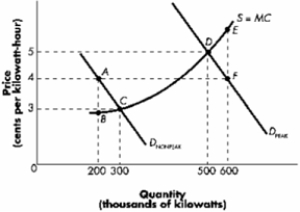
-Refer to Exhibit. If customers are charged 4 cents during the non-peak period, it is:
A)not efficient because the marginal benefit is greater than the marginal cost
B)efficient because marginal benefit is equal to the marginal cost
C)cannot determine
D)none of the above

-Refer to Exhibit. If customers are charged 4 cents during the non-peak period, it is:
A)not efficient because the marginal benefit is greater than the marginal cost
B)efficient because marginal benefit is equal to the marginal cost
C)cannot determine
D)none of the above

Unlock Deck
Unlock for access to all 50 flashcards in this deck.
Unlock Deck
k this deck



